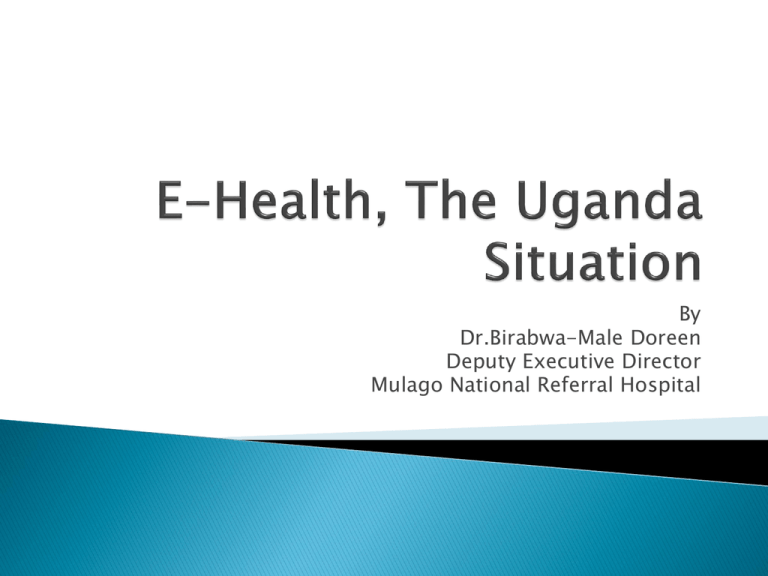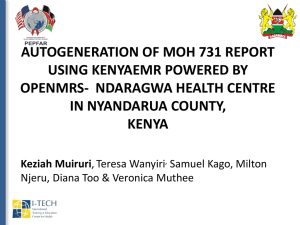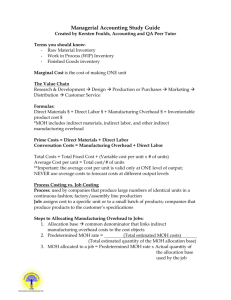E-Health in Uganda: Situation, Initiatives & Challenges
advertisement

By Dr.Birabwa-Male Doreen Deputy Executive Director Mulago National Referral Hospital Uganda is a small country of 236,000sq km in the Eastern part of Africa Population is about 34million One of the fastest growth rate of 3.7% Independence 1962 More than 60 districts 2 National referral Hospitals, Mental Health 13 Regional Referral Hospitals More than 20 district hospitals Many PNFP facilities Health Centre IV, III and II About 25 ministries MoH and ICT are some of them The Uganda Communications Commission(UCC) undertook the e-health project Other initiatives from OPM Commitment to fully establish e-health The journey has just began Good prospects Mulago is the National Referral and Teaching Hospital For Makerere College of Health Sciences Situated In the Northern Part of Kampala City, which is the Capital City It came into existence in 1923 and 1960 Bed capacity is 1600 beds Clinical Services Division Medical Doctors, Nurses, Pharmacy, Laboratory and other Paramedical Staff Support Staff Department which includes HR, Accounts, IT, Customer Care, Stores, Engineering, Medical Records, Catering, Transport and Administration The hospital is therefore very big and busy I am Deputy Executive Director for two years now I am a Paediatric Surgeon by training and therefore a Clinician previously The use of available systems and methods to facilitate health service delivery Application in any department Supply chain management Referral and counter-referrals Tele consultations Tele conferencing Accessing international information Attending international conferences Government Project to Enhance e-health in Uganda Started 2012 for 5 yrs Executed jointly by the MoH and UCC Work with local beneficiaries who are in the districts Regional referral Hospitals, district Hospitals and Health Centre IVs Focus is on 1) Health management Information System(HMIS) 2)Telemedicine(basic and Advanced) ◦ Will eventually cover 53 districts 103 health facilities(53 Hospital and 69 Health Centre IVs) The establishment consists of: ◦ Resource Centre at the MoH Hdq. ◦ computer centres at the beneficiary facilities ◦ Local Area Network ◦ Fibre-optic network ◦ Telemedicine equipment ◦ Solar Power equipment ◦ National Grid connection Web Cameras Digital Cameras Scanners Software: ◦ Internet connectivity ◦ Data point at each facility ◦ e-HMIS by MoH ◦ E-office services ◦ Tele software ◦ Local connectivity Expected out-put ◦ Virtual linkage to the MoH resource centre, District Health Hdq, other hospitals ◦ Accessibility of the MoH portal ◦ e-CMEs ◦ Online Medical Journals ◦ e-libraries ◦ e-consultations Eventually the community will be empowered with e-learning Easier communication between the community and health facilities Harmonize referrals Improved patient Care Well informed health workers Management of the project: ◦ MoH ◦ Uganda Communications Commission(UCC) ◦ Steering Committee from both ◦ Selected provider Funding: ◦ MoH ◦ UCC ◦ Beneficiary Facilities ◦ Local Government ◦ ICT budget for maintanance and operational costs Other support: ◦ M&E ◦ Supervision ◦ Bridging gaps ◦ Computer Applications ◦ Space and security ◦ Hardware Other applications o e-infrastructure development o e-records management o unique patient ID o drugs and stock management o stakeholders networking Situated Capital in the Northern part of Kampala City of Uganda National Referral and Teaching Hospital for MakCHS and other institutions around it Founded Bed No in 1913 and 1962 capacity of 1,650 of staff is 3,000 Therefore big and very busy hospital Top management Clinical Services Division ◦ ◦ ◦ ◦ ◦ Surgical Medical Paediatrics Obstetrics and Gynaecology Diagnostics Deputy Executive Director, in charge of Clinical Services Support staff ◦ ◦ ◦ ◦ ◦ ◦ ◦ ◦ Administration Accounts Human Resources Stores Customer Care Security Procurement ICT Existing Services ◦ Medical Records ◦ Supplies and Drugs ◦ Human Resources ◦ Telemedicine ◦ Customer Care ◦ Finances Patient Records are not computerised centrally Some decentralised data Birth and Deaths Initiative of UNICEF and Registrar General Restricted access at various points Hard copies can be printed This system has been computerised and is working well Initiative by Uganda Govt. through OPM IICS Able to monitor availability of drugs, expiries, movement Restricted access depending on need Will computerise Patients’ data Computerised data Includes biometrics Centralised in Public service Restricted Access Clean Pay rolls Better management of attrition Initiative of GoU through the World Bank Exercise is on-going Project by GoU through MoH Linked to India Effort to link up with other centres Tele-conferencing is accessed through the MakCHS, very good equipment It is yet to be efficiently utilised SMS platform Call Centre Information to Clients about Hospital Services Feed back for any help This is an IFMIS Centrally managed at the MoF No Cheques Electronic vouchers and money transfer Country wide Very restricted access 1. Not yet embraced e-health 2. Need to synchronise activities to avoid duplication 3. Fundamental change in attitude 4. Lack of skills 5. Lack of hardware and software 6. Security for hackers and thefts 7. Unreliable National grid power 8. Financing Opportunity Listening to me


